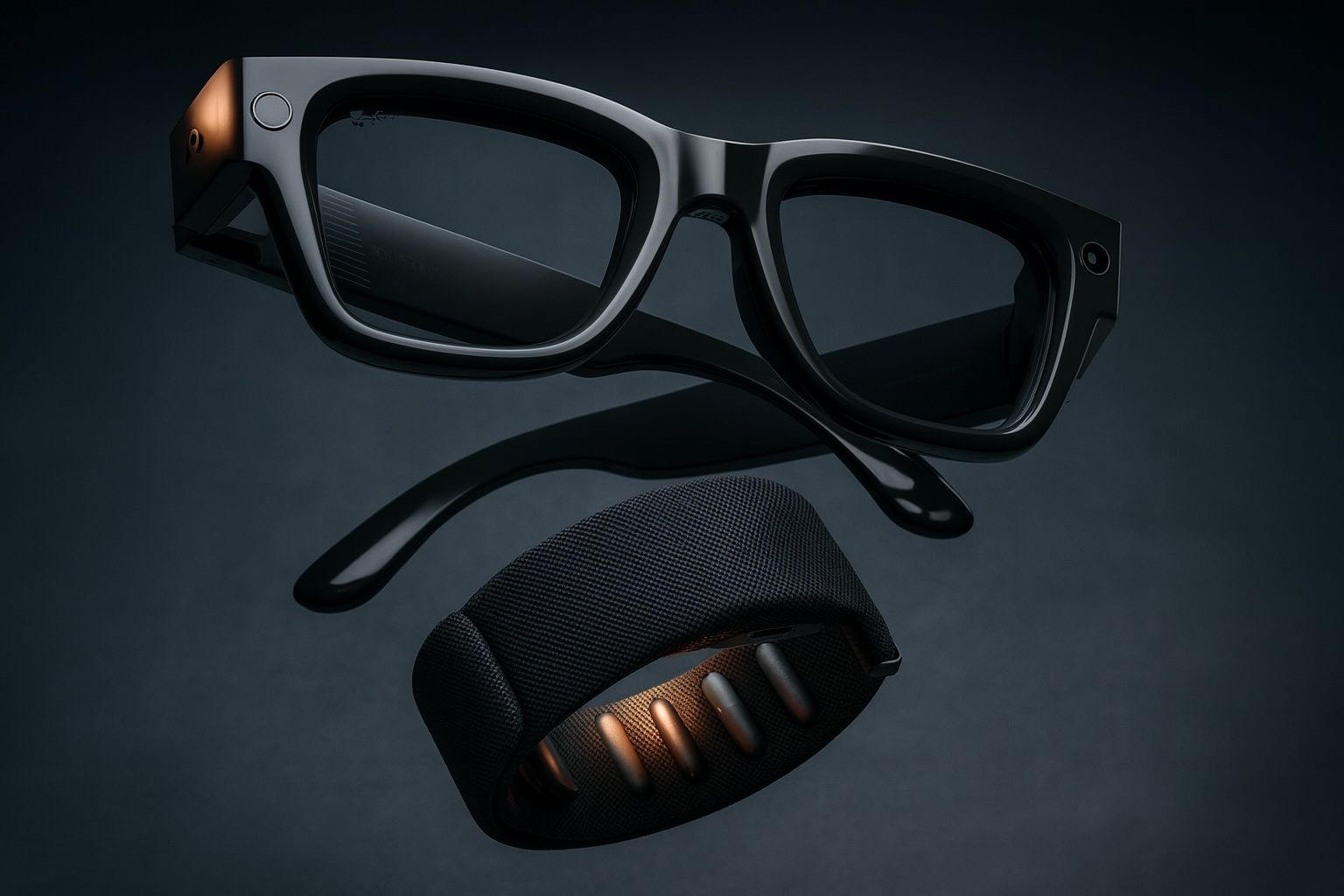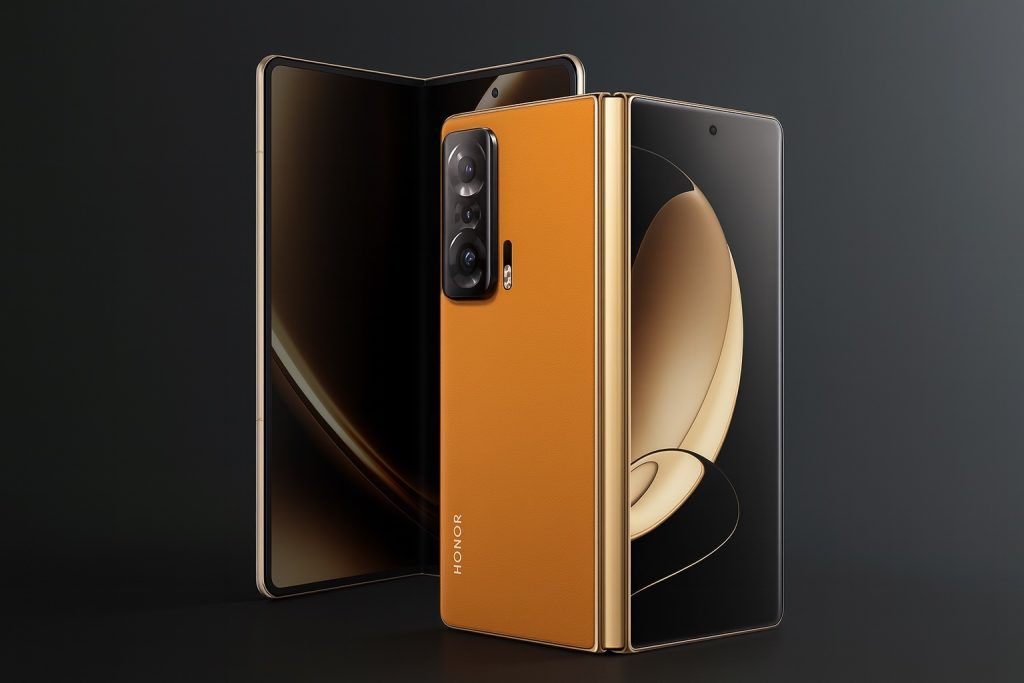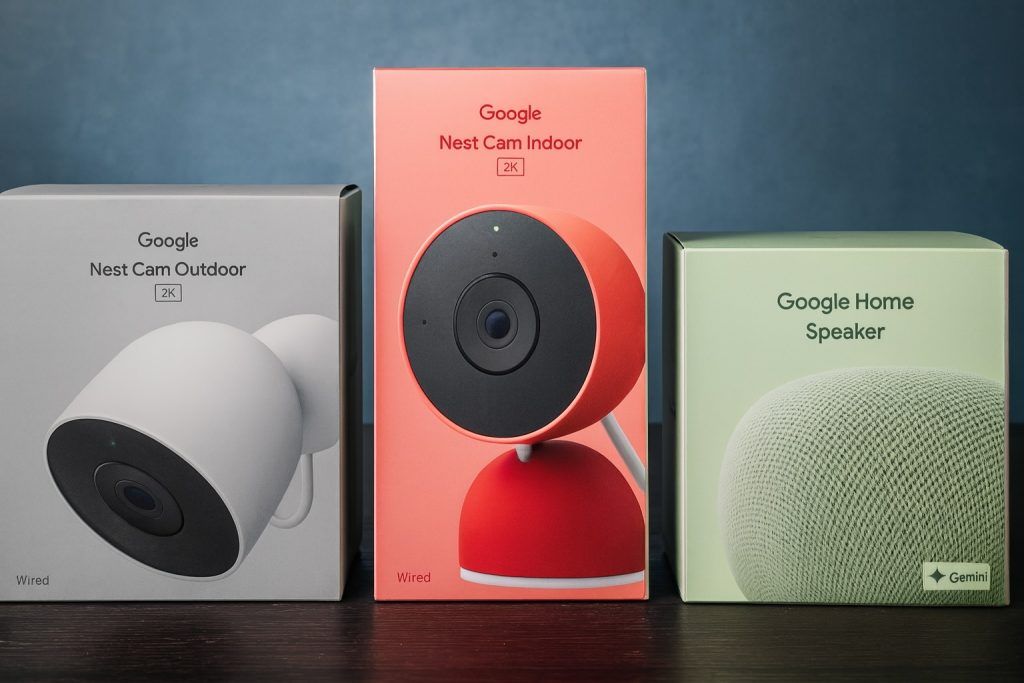- Meta & Ray-Ban’s second-gen smart glasses: Meta (Facebook) and Ray-Ban have launched new Ray-Ban Meta (Gen 2) smart glasses that look like classic Ray-Bans but pack tech inside. They feature a 12 MP camera (capable of 4K stills and up to 3K video recording), open-ear stereo speakers, and Meta’s built-in AI voice assistant for hands-free commands [1] [2]. Battery life is about 8 hours (an upgrade from ~6 hours on Gen 1) [3], so they can last through a day of casual use. You can snap photos or videos by saying “Hey Meta, take a photo” and even get real-time translations of speech or text via the glasses’ AI features [4].
- Pricing & models: The standard Ray-Ban Meta 2 glasses start at $379 for the basic clear or sun-glass models [5] (with higher prices for polarized or transition lenses). They come in stylish frames like the iconic Wayfarer and a round “Skyler” design. Meta also revealed a higher-end “Ray-Ban Meta Display” edition with an actual display built into the lens (for AR visuals) and a wrist-worn “Neural Band” controller, priced around $799 [6] [7]. This suggests Meta is pushing toward true augmented-reality eyewear at a still premium but far lower cost than bulky AR headsets on the market.
- Smart glasses competition: Meta’s Ray-Bans face a range of rivals, each taking a different approach. Amazon’s Echo Frames (3rd Gen) look like regular glasses with Alexa built-in (no camera) and cost about $269.99, offering audio and voice assistance only [8]. Snap’s latest Spectacles (AR Edition) go the opposite direction – they have transparent AR displays and dual cameras for augmented reality effects, but are only available as a developer kit (with ~45 minutes battery life per charge) [9]. Google is testing prototypes with its advanced “Gemini” AI and AR translation features (no consumer product yet), and Apple’s current foray is the Vision Pro headset (a $3,499 mixed-reality device) while reportedly developing lightweight AR glasses for the coming years [10]. There are also niche players like XReal, TCL, and Rokid selling tethered AR display glasses (~$400) that can project a virtual big screen from your phone, though those lack cameras or any built-in smarts [11]. In short, Meta’s Ray-Ban glasses aim for a middle ground of style + camera + audio, whereas others either keep it simple (audio-only) or focus on heavy-duty AR visuals.
- Privacy concerns: Having a camera on your face raises inevitable privacy questions. Ray-Ban Meta glasses have a tiny LED that lights up during recording, but reviewers note it’s a “gentle” white light easily overlooked in broad daylight [12] – meaning bystanders might not realize they’re being recorded. To address fears, Meta says its AI assistant won’t do face recognition or identify people [13]. However, researchers have already hacked the glasses to add unofficial facial recognition, pulling up people’s info in seconds [14]. Incidents have stirred debate – for example, a college football staffer was accused of using Ray-Ban camera glasses to covertly film opponents’ signals in a “spy scandal” [15]. Some bars, gyms, and schools now ban smart glasses with cameras. Always-on microphones are another worry (even audio-only Echo Frames listen for “Alexa”). Overall, the public is split: some are intrigued by the tech, while others get uncomfortable or hostile when they realize they might be on camera without consent.
- Reception & outlook: Despite the concerns, Meta’s smart glasses have gained surprising traction. Over 2 million pairs sold within the first year [16], which Meta claims makes them the world’s best-selling “AI glasses” to date [17]. Early adopters love the convenience of capturing moments or getting info on the go hands-free [18]. Reviewers praise the glasses’ comfortable, lightweight design – one tech editor admitted he “forgot [he] was wearing anything tech-y” on his face after a while [19]. The Meta voice assistant also impressed some users with its speed and capabilities (one tester said he “nearly stopped using Siri” while wearing the Ray-Bans [20]). However, most experts see these as a niche gadget for now – “cool, but more of a novelty than essential tech,” as one reviewer put it [21]. They likely won’t replace your smartphone anytime soon, but they hint at a future where your eyewear could become a mainstream tech accessory. The race is on among Meta, Apple, Google, Snap, and others to see who can crack the formula for the first truly must-have smart glasses [22].
Meta and Ray-Ban Team Up on Smart Glasses 2.0
When you hear “smart glasses,” you might recall the ill-fated Google Glass or Snapchat’s toy-like Spectacles. Meta’s approach, in partnership with luxury eyewear maker Ray-Ban, is different: make smart glasses that actually look cool. The Ray-Ban Meta Smart Glasses (Gen 2) have the iconic Ray-Ban style – at a glance, most people wouldn’t know they’re anything more than regular glasses [23]. (They come in classic designs like the Wayfarer and a round “Skyler” frame, in various colors and even prescription options [24].) This “design first” philosophy is deliberate. Early smart glasses were often bulky or weird-looking, whereas these slip right into everyday fashion. A Tom’s Guide reviewer noted he was “surprised at how light they felt” and found them “remarkably light and comfortable,” to the point he forgot it was tech on his face [25]. That’s a big win for Meta and Ray-Ban – if you’re going to wear a device on your face, it needs to feel natural.
What’s new in Gen 2? The second-generation Ray-Ban Meta glasses bring meaningful improvements over the original 2021 Ray-Ban Stories. The design remains similar, but under the hood Meta upgraded the camera and battery, and added more smarts. The built-in camera is now 12 megapixels (up from 5 MP in Gen 1) and can record up to 3 minutes of video at 3K resolution (30 fps) [26] – a big step up from the first gen’s 30-second 1080p clips. Despite the extra power, the battery life increased to around 8 hours per charge [27] (depending on use), thanks to efficiency tweaks. Meta also integrated its new “Meta AI” voice assistant into the glasses – this is a generative AI helper introduced in 2023 that lives in the cloud but is triggered by the device [28]. In Gen 1, you could use basic voice commands; now in Gen 2 you can ask more complex questions (“Hey Meta, what’s the weather in Paris tomorrow?”) and get spoken answers, or even have the glasses translate a conversation in real-time into your ear [29]. In short, Gen 2 is smarter, lasts longer, and shoots sharper footage, all while keeping the same timeless style and wearable comfort.
It’s worth noting Meta has signaled even bigger ambitions beyond this “Gen 2” device. In 2025, Meta announced a Ray-Ban Meta “Display” model – effectively a pair of smart glasses with a transparent micro-display in one lens for true augmented reality, plus a wristband for neural control [30]. That model (priced around $799) includes features like seeing your messages or maps in your field of view [31]. It’s not a mainstream product yet, but it shows where Meta wants to go. For now, the widely available $379 Ray-Ban Meta 2 glasses focus on simpler (but practical) features: camera, audio, and an AI voice assistant – all packed into a stylish pair of specs.
Features: Camera in Your Glasses, Music in Your Ears, and an AI “Assistant”
What can these Ray-Ban Meta smart glasses actually do? A lot of the appeal boils down to hands-free convenience. Instead of pulling out your phone to take a photo, you can just tap the frame or give a voice command to snap what you’re seeing. The glasses’ 12 MP camera is mounted at the hinge area and captures a wide field of view (perfect for POV shots). It can record short videos (up to 3 minutes continuous) in crisp 3K resolution [32]. For context, that’s higher than standard 1080p and on par with some action cameras. One early user said the pictures were “surprisingly close” to phone photos in quality – vibrant and clear enough that he had to double-check they were taken with glasses, not his iPhone [33]. The glasses wirelessly sync to your phone (via the Meta View app); you can quickly transfer your clips and even live-stream directly from the glasses to social media. In fact, they have a feature where you can broadcast directly to Instagram/Facebook Stories from your first-person perspective [34], essentially turning you into a walking live camera. A tiny forward-facing LED light blinks when you’re recording to signal to others, but as mentioned, it’s subtle – arguably too subtle for comfort in public settings [35].
For audio, the Ray-Ban Meta glasses have open-ear speakers built into the arms (near your ears) and microphones. This means you can listen to music, podcasts, or take phone calls through your glasses – no earbuds needed. The sound is surprisingly clear and sufficiently loud for personal use, while designed not to leak much noise to those around you [36]. Reviewers describe it as similar to using earbuds in transparency mode, except nothing is actually in your ears [37]. You can hear the world around you, which is safer for activities like walking or biking, yet you still get your audio. The touch-sensitive frame lets you swipe or tap to adjust volume and playback, just like headphone controls [38]. And since there are microphones, you can also use the glasses to talk on calls or give voice commands. Pair them to your smartphone via Bluetooth, and they essentially act as a wireless headset – one that’s built into your eyewear.
The star of the show, however, might be the Meta AI voice assistant integration. By saying “Hey Meta,” you awaken a digital assistant that can do a bunch of tasks completely hands-free. It’s like having Siri or Alexa in your glasses, but with Meta’s AI brains and some unique tricks. You can ask general knowledge questions (“Hey Meta, who won the World Series in 2010?”) and get a quick spoken answer. You can control your music (“Hey Meta, play my workout playlist on Spotify”) or have it read you the news headlines. You can send a text or even dictate a WhatsApp message. Perhaps most impressive, the glasses’ AI has a vision component: it can analyze what you’re looking at through the camera (with your prompt). For example, you can ask, “Hey Meta, what is this building?” or “Hey Meta, translate this sign for me,” and it will attempt to recognize the scene or text and respond [39] [40]. The Ray-Ban glasses support real-time translation for several languages – essentially acting as an in-ear translator if you’re talking to someone in French or Chinese [41]. This begins to fulfill the sci-fi promise of augmenting reality with information. That said, the AI isn’t perfect – far from it. Testers found it will sometimes confidently get things wrong. Gizmodo’s reviewer had fun with this, showing how the glasses’ AI would misidentify niche objects in view: it thought a Samus Aran figurine (from Metroid) was Iron Man, and a PlayStation 5 was a PlayStation 4 – basically it will “confidently lie to you” if it doesn’t know the answer [42]. So, take the AI’s responses with a grain of salt. It’s a nifty party trick and occasionally genuinely useful (especially for translations), but it’s not a reliable oracle yet [43] [44].
One more feature that early adopters enjoy is the ability to capture moments without holding a camera. For example, travelers can record their journey in first-person – imagine biking through a scenic route and getting a hands-free video of the experience, or parents filming playtime with their kids while still interacting. Some vloggers have taken to live-streaming via the Ray-Ban glasses, so viewers see exactly what the wearer sees. All of this is done in a form factor that’s much less obtrusive than a GoPro strapped to your head. In a sense, Ray-Ban Meta 2 is bringing the concept of “lifelogging” (recording snippets of your life) to the mainstream [45] [46] – albeit in a controlled way (short clips, not continuous recording). Whether that’s exciting or unnerving depends on your perspective, which brings us to the privacy issue…
How Do Meta’s Glasses Stack Up Against Other Smart Glasses?
Smart glasses are suddenly a hot tech category, with big players taking very different paths. Meta’s Ray-Ban approach is to embed a bit of camera, a bit of audio, and a bit of AI into an everyday-fashion package. How does that compare to what others are doing?
- Amazon Echo Frames (3rd Gen): Amazon’s smart glasses forego any camera or display – they’re all about audio and Alexa. In design, Echo Frames look quite ordinary (no Ray-Ban cachet, but not nerdy either) and are priced a bit lower (about $270) [47]. Their selling point is having Alexa on your face: you can talk to Amazon’s voice assistant anytime, hear turn-by-turn directions, get calendar reminders, listen to music, etc., through the frame’s open-ear speakers. Reviews of the latest Gen 3 Echo Frames praise improvements like better sound quality, clearer calls, and a more comfortable fit [48] [49]. One TechRadar reviewer said wearing them was “a little like having a secret superpower… Alexa always waiting in the wings, ready with a song, a podcast, a notification, an answer” [50]. However, they are relatively “dumb” glasses in the sense that there’s no camera, no AR, and they rely entirely on pairing with your phone. They also lack any display or visual notifications. In summary, Echo Frames are great if you want a discreet headset for Alexa and audio, but they won’t satisfy someone who wants to take photos or get visual info from their glasses.
- Snap Spectacles: Snap Inc. (the company behind Snapchat) has been experimenting with smart glasses for years. The first few Spectacles were basically camera sunglasses for Snapchat posts. The latest Spectacles (2023/2024) take a leap into augmented reality. They have dual cameras and waveguide displays in the lenses, allowing the wearer to see 3D digital overlays on the real world. For instance, you could see a flying dragon animation through the glasses that others with Spectacles can also see in the same space – a shared AR experience. Snap’s current AR Spectacles are not sold to the public; they are a developer edition (Snap lends them out for ~$99/month to creators) [51]. They’re also quite limited in practicality: only ~30–45 minutes of battery life, and they look bulkier than normal sunglasses [52]. That said, those who tried them report the experience is mind-blowing. A Tom’s Guide writer testing Snap’s AR glasses said the company is “successfully making shared AR experiences a reality” and that “the future of smart glasses looks to be a lot of fun” [53]. In other words, Snap is pushing the envelope on what smart glasses can do (full-color holographic effects and multi-user AR), but it will be a while before such advanced capabilities are polished and power-efficient enough for consumers. When comparing to Ray-Ban Meta 2: Snap’s glasses are more technologically ambitious (true AR), but Meta’s are far more practical and stylish for daily use right now.
- Google’s prototypes: Google notoriously tried and stumbled with Google Glass over a decade ago, but they haven’t given up. Recently Google has been quietly showing demos of next-gen smart glasses that combine Google Lens style visual recognition with a voice assistant. In one demo, a user wearing Google’s prototype asked aloud about a painting in front of him, and the glasses instantly described it – basically doing a live Google search on what the camera sees [54]. Google also previewed AR glasses that can translate foreign text in your field of view, and even subtitling a conversation in real-time (similar to Meta’s translation feature) [55] [56]. These devices aren’t commercially available yet, but Google’s concept is clearly aiming for AI-enhanced AR – letting you see data on the world around you. As for hardware, little is known publicly, but they did emphasize privacy (e.g. no face recognition, much like Meta’s stance) [57] [58]. If and when Google releases new smart glasses, they’ll likely leverage Google’s powerful AI (Google Assistant, Google Lens, etc.) and huge Android ecosystem, posing a serious challenge to Meta. But for now, Meta’s Ray-Bans have a head start in the real world.
- Apple’s route (Vision Pro and beyond): Apple hasn’t released “glasses” per se, but their upcoming Vision Pro headset (expected in 2024) shows Apple’s AR/VR strategy. Vision Pro is more of a ski-goggles-style mixed reality headset than everyday glasses – it’s loaded with 12 cameras, multiple sensors, 4K displays for each eye, and a $3,499 price tag [59]. It can do incredible immersive things (like record 3D videos of your surroundings, or overlay virtual screens in your view) [60], but you definitely won’t be wearing a Vision Pro on the subway or to the café. It’s a different category. However, Apple is rumored to be developing lightweight AR glasses for down the line (2025–2026 or later) [61]. Those would presumably look more like regular spectacles and tie into the iPhone and Apple’s ecosystem (using Siri for voice, etc.). Some tech writers have noted that Meta, by partnering with Ray-Ban, has “caught Apple off guard” by actually shipping a popular smart glasses product first [62]. Apple usually leads in consumer tech, so it’s interesting to see them playing catch-up here. It wouldn’t be surprising if Apple’s eventual smart glasses integrate tightly with Apple services (Maps, FaceTime, Music) and emphasize privacy and style – which could raise the bar even further. In the meantime, Ray-Ban Meta 2 enjoys a period of relatively little direct competition in the “normal-looking, camera-and-audio glasses” niche.
- Other players: Aside from the big names, there are specialized devices like XReal (formerly Nreal), Rokid, TCL NXTWear, etc. These are often billed as “AR glasses” but are basically personal displays – they plug into your phone or laptop and act like an external screen floating in front of your eyes (great for watching movies or gaming on a giant virtual screen). They typically have no cameras, no on-board computing (they rely on the tethered device), and no open-ear speakers (some use earbuds). They cater to a different use-case (media consumption rather than capturing or assistant functions). At around $399, XReal Air glasses, for example, give you a stunning HD image equivalent to a 130-inch screen, but again, they don’t record or “understand” the world around you [63] [64]. For someone wanting to watch content, those are neat; but for someone wanting to record life or have an AI guide, Ray-Ban Meta is the more relevant option.
In summary, Meta’s Ray-Ban Gen 2 glasses occupy a sweet spot in the current market: they’re not as technologically extreme as Snap’s AR goggles or Apple’s Vision Pro, but they offer more capabilities (camera, voice AI) than simple audio glasses like Echo Frames. At ~$379, they’re also within the price range of high-end sunglasses or wireless headphones, making them one of the most accessible smart eyewear options. The competition is heating up on all fronts – audio-focused wearables, camera glasses, and AR headsets are all converging – but Meta and Ray-Ban have carved out a strong early lead in the stylish, multi-function smart glasses space.
The Privacy Problem: Are People Ready for Camera Glasses?
Smartphones turned everyone into a photographer, but at least when someone holds up a phone, you know you might be on camera. Smart glasses change that dynamic – and it’s causing some social friction. Privacy is the thorniest issue facing devices like Ray-Ban Meta 2. The device has a conspicuous function (recording video/audio in public) with an inconspicuous form. As mentioned, the only cue is a tiny white LED on the frame that lights up during recording, and in bright daylight it’s easy to miss [65]. This has led to fears of surreptitious filming. We’ve already seen some real incidents: the sports world was surprised by news of a college football staffer allegedly using Ray-Ban smart glasses to secretly film opposing teams’ signals – a high-tech twist on cheating scandals [66]. In some cases, bars and restaurants have asked customers to take off or turn off smart glasses to protect patrons’ privacy. Gym-goers have expressed discomfort if someone seems to be wearing camera glasses while everyone’s working out.
Meta is aware of these concerns. They deliberately chose not to enable any form of facial recognition or automatic identification of people in the Ray-Ban glasses, even though the hardware could technically support it [67]. (In fact, Meta was likely scarred by the backlash to Google Glass, where wearers were pejoratively dubbed “Glassholes” for pointing a head-mounted camera at unwitting people.) Meta’s privacy policy for the glasses also tries to assure that the AI assistant won’t remember photos you take in a way that could harm privacy – e.g. if you ask “Hey Meta, who is that person?” it will refuse to say. Despite these measures, it didn’t take long for hackers to demonstrate that unauthorized face recognition is possible: researchers showed they could modify the glasses’ software to identify strangers on the street by cross-referencing social media photos [68]. That sets off alarm bells, because it means the only thing preventing such use is software rules, not physical impossibility. Privacy advocates worry that as these glasses proliferate, we could drift into a surveillance society where anyone might be recording or even identifying you at any time without consent.
The microphone aspect is another angle. The Ray-Ban Meta glasses (and Echo Frames, etc.) are always listening for the “Hey Meta” wake word. That means, theoretically, snippets of audio could be recorded or misused. Meta says audio stays local until the wake word is detected, similar to how Alexa or Siri work. But people are understandably skeptical given Big Tech’s track record on data. Even if you trust the device, there’s the matter of etiquette: Is it okay to talk out loud to your glasses in public? Some users report getting weird looks when they suddenly say “Hey Meta” in a quiet grocery aisle. And if someone’s having a private conversation next to you, they might not love the fact that your glasses have mics, even if you’re not actually recording.
Society has begun grappling with these questions. We’ve come a bit farther from the days of Google Glass (which was so ahead of its time in 2013 that it sparked immediate backlash). Today, people are more used to cameras being everywhere (security cams, GoPros, phone cameras), and younger generations are generally more open to being recorded as part of life. The Ray-Ban stories haven’t generated the same level of public outcry as Google Glass did [69], perhaps because they look normal and have been adopted slowly. Some users report that nobody even notices they’re wearing smart glasses, or if they do, they don’t realize when it’s recording [70] [71]. On the other hand, there have been instances of pushback: anecdotal reports of people being asked to take them off in sensitive areas, or that feeling of “Are they filming me?” causing social tension. It’s telling that virtually every tech reviewer, even those who love the Ray-Ban Meta glasses, brings up the privacy issue unprompted [72]. It’s the elephant in the room that won’t go away.
For now, using smart glasses responsibly means the onus is on the wearer to respect others. Meta includes some guidelines – for example, the glasses will LED-blink and make a sound when starting to record (to alert people nearby), and they encourage asking for consent in intimate settings. But clearly, norms are still forming. Will we eventually accept camera glasses like we accepted smartphone cameras? Or will there always be a stigma (“uh oh, that person’s wearing those spy glasses”)? The coming years – as these devices become more common – will likely lead to new rules, maybe even laws, around where and how they can be used (just as smartphones led to rules against filming in theaters, etc.). Privacy is the biggest social hurdle smart glasses must overcome to go truly mainstream.
What Reviewers and Tech Experts Are Saying
Ever since Meta’s Ray-Ban smart glasses hit the market, tech journalists and early users have put them under the microscope. The verdict so far: impressive blend of style and tech, but not yet a necessity. Here’s a sampling of expert opinions:
- Comfort & Style – a Big Win: Many reviewers highlight that these actually feel like real glasses. “I really did forget I was wearing anything tech-y on my face,” one Tom’s Guide editor wrote after a few hours with Ray-Ban Meta 2 [73]. That sentiment is huge; previous wearables always felt like gadgets, whereas these just feel like sunglasses. The classic Ray-Ban design and modest weight make them easy to wear for extended periods. A tech writer for NY Magazine’s Strategist confessed the technology in the glasses was “much better than I expected” and praised the fact that they “don’t look too different from standard Ray-Bans… and look great on just about anyone.” [74] For a category often mocked for geeky aesthetics, getting fashion credibility was half the battle, and Ray-Ban/Meta seem to have achieved that.
- Battery & Usability: Reviewers note the improved battery life means you can use the glasses on and off through a day without anxiety. In testing, some were able to get through most of a day of casual photo/video and music listening with charge to spare (the charging case can top them up in between uses). The consensus is that ~4 hours of continuous use per charge (or 8 hours of intermittent use) is adequate for a device of this kind [75] [76], though of course longer is always better. Control-wise, the touch gestures on the frame for volume and the physical capture button are considered intuitive, since they mimic familiar headphone controls [77]. There is a learning curve in remembering you can ask your glasses to do things, but once people got used to saying “Hey Meta” for tasks, some found it surprisingly natural. In fact, as mentioned, one reviewer said he started using Meta’s assistant instead of Siri because it was faster for certain queries [78] – likely a testament to Meta’s investment in AI responsiveness. On the flip side, a limitation pointed out is that the glasses’ functions are somewhat siloed – they’re great for Meta’s own ecosystem (Facebook/Instagram sharing, Messenger calls, Spotify via Meta’s integration), but they don’t natively integrate with every app on your phone. For example, you can’t yet get turn-by-turn Google Map directions spoken by the glasses automatically, or have your iMessages read out – at least not without some manual workarounds. So, they’re convenient, but not a total phone replacement.
- Camera and Audio Quality: The 12 MP camera exceeded some reviewers’ expectations for such a tiny lens. It obviously won’t beat an iPhone 15 or a dedicated camera in low light or detail, but in good lighting it takes social-media-ready shots and videos without fuss. A Wired review (via NYMag) noted the photos were good enough that they started using their phone camera a bit less for casual snaps [79] [80]. The ability to shoot from eye-level perspective results in fun, immersive footage – though a few reviewers mentioned you have to train yourself to hold your head/eyes steady for the best shots (since there’s no viewfinder unless you buy the new Display model). Audio got positive marks for what it is: it won’t replace high-end headphones for music aficionados, but for everyday listening and calls it’s clear and plenty loud. Importantly, there’s minimal sound leakage, so you’re not going to annoy people nearby with your music [81]. One caveat noted: in very noisy environments, the open speakers can be hard to hear (as they don’t seal to your ear), and likewise the mics can pick up a lot of background noise – so they perform best in moderate environments.
- Meta AI Assistant: This feature garnered both excitement and eye-rolls. On one hand, the idea of asking your glasses anything and getting an answer feels futuristic. Reviewers enjoyed using it for things like quick trivia, language translations, or controlling music hands-free. The fact that it can describe what the camera sees (using AI vision) blew some minds, until its limits showed. Gizmodo’s tester gave perhaps the harshest critique, saying the glasses’ AI “will confidently lie to you… and just like [your] dad, it thinks everything in big red armor is Iron Man.” [82] In other words, it’s fun to try identifying stuff via the glasses, but it’s often wrong for now. Most suggest treating the AI as a bonus feature – potentially very powerful in the future, but currently a bit of a hit-or-miss gimmick. The good news is Meta can likely improve it over time with software updates (the AI processing is cloud-based). But out-of-the-box, don’t expect magic every time; you’ll get some wow moments and some nonsense.
- Not for Everyone (Yet): Almost every review concludes that while Ray-Ban Meta glasses are cool, they are “not yet essential.” As Business Insider put it after testing: “there’s little they can do that your phone can’t already do better” in daily life [83]. It’s a classic early-adopter gadget – fantastic for tech enthusiasts, content creators, or people who love trying new gear, but a harder sell for the average consumer who might wonder why they need this. Wirecutter’s take (via the NYTimes) echoed that sentiment, noting that some functions are limited and the glasses don’t integrate with all the apps people use [84]. For example, if you’re an iPhone user deep in Apple’s ecosystem, a lot of Meta’s features won’t tie into your Apple services. Moreover, if you don’t frequently take POV videos or hate talking to voice assistants, the use cases shrink. Bottom line: reviewers say Gen 2 Ray-Ban smart glasses are an exciting step forward – a “fun toy” and even “surprisingly useful” in certain moments [85] [86] – but they’re not a must-have for most people… at least not yet.
- The inevitable privacy talk: It bears repeating that even the most upbeat reviews raise concerns about recording people or the social awkwardness of wearing a camera. Some reviewers tested reactions – e.g., one wore the glasses at family gatherings or at a cookout. In friendly private settings, people got used to it quickly, especially when the wearer would announce, “I’m taking a photo now.” But in public, a few mentioned they felt “a bit of terror” contemplating wearing them around strangers [87]. The consensus from experts: the tech is ready for prime time, but society is almost ready – not quite fully comfortable. As one commentator quipped, we might need a new etiquette for smart glasses just like we eventually developed etiquette for smartphone use in public [88].
Public Adoption and the Road Ahead
Given the mix of praise and skepticism, how are these smart glasses actually doing in the real world? By the numbers, Meta and Ray-Ban have reason to be optimistic. They reportedly sold over 2 million units of the first-gen Ray-Ban Stories within a year [89] – far exceeding the uptake of earlier wearables like Google Glass or Snap’s Spectacles. This indicates there is real consumer interest, especially when the product is positioned as a pair of fashionable glasses that just happen to be high-tech. Many of those buyers are presumably using the glasses in casual, everyday ways: taking hands-free vacation videos, listening to music on a walk, recording kids’ birthday parties, and so on. On social media, you can find Ray-Ban smart glasses users sharing POV clips of hikes, skateboarding tricks, dog-walking adventures, and more – content that has a unique feel because it’s from eye-level and hands-free. This kind of grassroots usage is something previous smart glasses never achieved at scale.
That said, we’re still in the early adopter phase. For every person raving about their Ray-Ban Meta glasses, there’s another saying “neat device, but I wouldn’t spend $379 on it.” Surveys and anecdotal reports suggest most people still don’t quite see the need for smart glasses in their life – much like how smartwatches were perceived when they first came out. It took a few generations and the right mix of features (and price drops) for Apple Watch and others to catch on broadly. Smart glasses might follow a similar trajectory. At first, a niche of enthusiasts use them (e.g. gadget lovers, vloggers, professionals who can benefit from hands-free cameras). If the products keep improving – better battery, more apps, maybe AR displays – they could gradually win over more of the mainstream. One encouraging sign: younger consumers seem more open to it. Snapchat Spectacles, despite their limited success, proved that Gen Z was willing to wear camera glasses as a fun trend. By partnering with Ray-Ban, Meta tapped into a bit of that “cool factor” while also appealing to older users who just like Ray-Ban design. It’s a clever straddle of demographics.
Looking ahead, the competition is only going to intensify. Amazon is iterating on Echo Frames (now on Gen 3) and improving them steadily [90] – they might not have a camera, but Amazon might carve a solid niche for those who want an always-available voice assistant. Snap is likely to eventually release a consumer AR Spectacles version (they’re aiming for around 2026 for a mass-market AR glass launch) [91]. If Snap can translate the fun of their developer AR glasses into a user-friendly, affordable product, they could revive the Spectacles hype on a bigger scale. Google is the wildcard – if they launch something with their AI prowess, it could leapfrog what’s on the market (imagine glasses that seamlessly answer anything using Google’s knowledge graph and maybe show you info on a heads-up display). And of course, everyone is watching Apple. If Apple enters the smart glasses arena in the next couple of years, it could be a game-changer, given their loyal user base and integration of hardware/software. A TechCrunch editor noted that Apple’s heavyweight Vision Pro headset is impressive but impractical for daily use, and that “Apple needs to enter the arena of lighter hardware” to compete with what Meta and Google are doing in glasses [92]. In other words, even industry insiders expect Apple will feel pressure to respond to Meta’s Ray-Ban project with something of its own.
For Meta’s part, they seem committed for the long run. CEO Mark Zuckerberg has often talked about augmented reality being the “next computing platform” after smartphones – and smart glasses are a stepping stone to that future. Meta’s advantage is they have a partnership with one of the world’s largest eyewear companies (Luxottica, which owns Ray-Ban), giving them a huge distribution and manufacturing edge. You can already walk into many Sunglass Hut or Ray-Ban stores and find these smart glasses on display, which normalizes them. Meta also priced them relatively reasonably to lower the barrier (at $379, it’s expensive for sunglasses, but cheap for a piece of consumer tech compared to, say, new smartphones or AR headsets). They even keep pricing consistent globally – e.g. $379 in the US and £379 in the UK – showing they want adoption worldwide, not just in Silicon Valley [93].
In the near future, we can expect software updates to expand what Gen 2 glasses can do (perhaps better AI features, more voice commands, integration with more apps). There might also be new styles – imagine smart aviators or other popular frames to attract different fashion tastes. And likely within a year or two, a Gen 3 device will come, perhaps with incremental improvements (maybe longer video recording, improved displays or projectors in the lens, etc.). By 2025 and beyond, Meta’s roadmap (including that “Display” model with AR capabilities) suggests they want to transition from simple camera glasses to true augmented reality glasses – without losing the style cred they’ve built.
The concept of an all-day, socially acceptable AR eyeglass is often called the “iPhone of smart glasses” – a device that would be a must-have and change how we live. We’re not there yet. But the Ray-Ban Meta 2 shows the industry is inching closer. As one Reddit user noted, these glasses feel “on the right track” [94]. They nail the basics (style, comfort, basic functionality) that make people actually want to wear them, and they hint at the possibilities to come (AI in your ear, a camera for your memories, maybe one day directions and notifications in your view). The coming years will reveal if Meta can maintain its lead and mass-produce more advanced models, and whether the public will fully embrace this new form of tech. For now, Ray-Ban Meta 2 is arguably the most polished and popular smart glasses on the market – a promising peek at a future where our eyewear is not just passive plastic, but a gateway to information and experiences [95] [96]. Whether that future arrives in a burst or evolves gradually, we’ll be watching – possibly through the lenses of our own smart glasses.
Sources: Mashable [97]; NYTimes/Wirecutter [98] [99]; TS2 Technology [100] [101]; Engadget [102]; Tom’s Guide [103]; TechRadar [104]; Gizmodo [105]; Business Insider [106] [107]; The Verge [108]; TechCrunch [109]; Snap Investor Report [110]; Mozilla Foundation [111].
References
1. ts2.tech, 2. ts2.tech, 3. ts2.tech, 4. ts2.tech, 5. ts2.tech, 6. ts2.tech, 7. ts2.tech, 8. ts2.tech, 9. ts2.tech, 10. ts2.tech, 11. ts2.tech, 12. ts2.tech, 13. ts2.tech, 14. ts2.tech, 15. ts2.tech, 16. ts2.tech, 17. ts2.tech, 18. ts2.tech, 19. ts2.tech, 20. nymag.com, 21. www.businessinsider.com, 22. ts2.tech, 23. nymag.com, 24. nymag.com, 25. ts2.tech, 26. ts2.tech, 27. ts2.tech, 28. ts2.tech, 29. ts2.tech, 30. ts2.tech, 31. ts2.tech, 32. ts2.tech, 33. nymag.com, 34. nymag.com, 35. ts2.tech, 36. nymag.com, 37. nymag.com, 38. nymag.com, 39. nymag.com, 40. ts2.tech, 41. ts2.tech, 42. ts2.tech, 43. ts2.tech, 44. ts2.tech, 45. ts2.tech, 46. ts2.tech, 47. ts2.tech, 48. ts2.tech, 49. ts2.tech, 50. ts2.tech, 51. ts2.tech, 52. ts2.tech, 53. ts2.tech, 54. ts2.tech, 55. ts2.tech, 56. ts2.tech, 57. ts2.tech, 58. ts2.tech, 59. ts2.tech, 60. ts2.tech, 61. ts2.tech, 62. ts2.tech, 63. ts2.tech, 64. ts2.tech, 65. ts2.tech, 66. ts2.tech, 67. ts2.tech, 68. ts2.tech, 69. ts2.tech, 70. ts2.tech, 71. ts2.tech, 72. ts2.tech, 73. ts2.tech, 74. nymag.com, 75. nymag.com, 76. nymag.com, 77. nymag.com, 78. nymag.com, 79. nymag.com, 80. nymag.com, 81. nymag.com, 82. ts2.tech, 83. www.businessinsider.com, 84. www.businessinsider.com, 85. ts2.tech, 86. ts2.tech, 87. ts2.tech, 88. ts2.tech, 89. ts2.tech, 90. ts2.tech, 91. ts2.tech, 92. ts2.tech, 93. ts2.tech, 94. ts2.tech, 95. ts2.tech, 96. ts2.tech, 97. x.com, 98. nymag.com, 99. nymag.com, 100. ts2.tech, 101. ts2.tech, 102. www.translatestocks.com, 103. ts2.tech, 104. ts2.tech, 105. ts2.tech, 106. www.businessinsider.com, 107. www.businessinsider.com, 108. ts2.tech, 109. ts2.tech, 110. ts2.tech, 111. ts2.tech










